The different types of cloth diapers explained
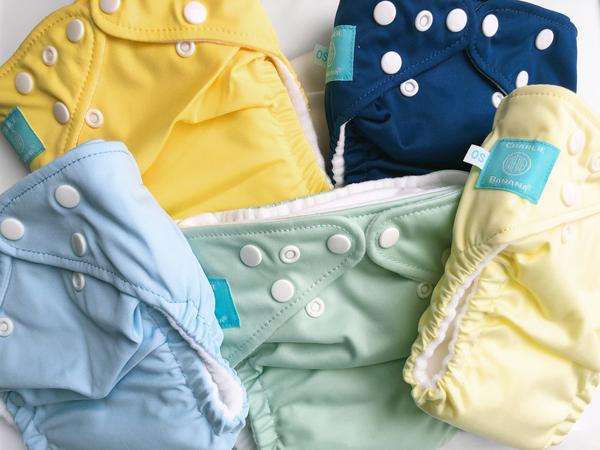
Inside the blog:
What are cloth diapers? What are flat cloth diapers? What are pre-fold cloth diapers? What are all-in-one cloth diapers (AIO)? What are all-in-two cloth diapers (AI2)? What are hybrid cloth diapers? Types of cloth diapers comparison chart How do you choose which cloth diaper is right for you? What makes Charlie Banana cloth diapers different?Cloth diaper confusion? We get it. Your mama’s days of cloth diapering are long gone. Nowadays there are so many types of cloth diapers to choose from. The number of options available can feel a bit overwhelming. And with names like “AIO” or “AI2,” it’s like you need a translator to explain what these different types of cloth diapers are.
But don’t worry; you got this. Our ultimate guide is all you need to understand the pros and cons of each. Read on to become that parent who knows it all. Well, at least when it comes to cloth diapers.
What are cloth diapers?
A cloth diaper is basically a reusable diaper you can wash and reuse. Modern cloth diapers have two things in common: they all have a waterproof outer layer and an absorbent inner layer or insert. The absorbent layer soaks up the moisture, while the waterproof outer layer prevents moisture from leaking through your baby’s diaper. Cloth diapers are easier to use than you might think, and come in various forms and colors. Many are also adjustable in size.
Here is the overview of the seven major types of cloth diapers.
What are flat cloth diapers?
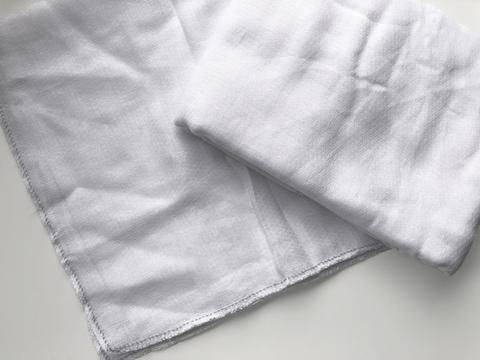
Flats are considered the OG of cloth diapering. Much like its name suggests, a flat diaper is a singled-layered piece of fabric that’s usually made of cotton. To fit your baby, it requires folding in a variety of ways to create a multi-layered, diaper-like shape. To secure flat cloth diapers, you need safety pins or clips. Plus, flats also require a diaper cover to help keep moisture inside the diaper.
Pros of flat cloth diapers:
- The most inexpensive cloth diapering option there is
- Can customize absorbency by layering more than one flat together
- Easy to adjust as baby grows
- Multi-uses: can be used as burp cloths, breastfeeding towels and more
Cons of flat cloth diapers:
- Require origami-like folding skills to get a snug fit
- Need safety pins, clips, or fasteners to secure
- Must use with a separate diaper cover
- Can be a challenge for babysitters or daycares if cloth diapering isn’t their thing
When should you choose flat cloth diapers?
Flat cloth diapers are the least expensive style of cloth diapers, but they also require the most skill and know-how. They are best suited for parents who want or need to cloth diaper on a budget, have some experience with cloth diapering, and are willing to put in some extra effort. If you are a beginner and looking for easy, quick diaper changes, you might want to consider some other options first.
What are pre-fold cloth diapers?
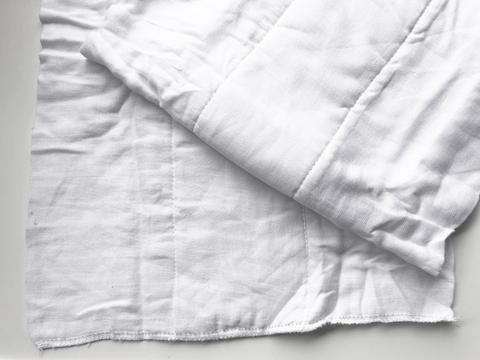
Pre-fold diapers are very similar to flat diapers, but are pre-folded into three panels with the middle panel being the most absorbent. Just like flats, pre-folds require safety pins or clips for fastening and a diaper cover to help prevent leaks. Because pre-folds are already layered, they can be a faster alternative to a flat diaper, while still being low in cost.
Pros of pre-fold cloth diapers:
- Relatively low in cost, like the flat diapers
- Already layered, so can be a faster alternative to a flat diaper
- Adjustable as baby grows
Cons of pre-fold cloth diapers:
- Still need to be folded into a diaper-like shape to fit the baby
- Require safety pins, clips or fasteners to secure
- Must be used with a separate diaper cover
- Again, this option can be difficult if your baby goes to a sitter or daycare
When should you choose pre-fold cloth diapers?
Pre-fold cloth diapers, like flats, are relatively cheap and versatile. They can be a more convenient alternative to flat diapers because they are already layered.
Prefolds are a little bit difficult to use when first starting out. They require folding, though the folding is less intensive than for flats.
Pre-fold diapers could be a good option if you are looking for an inexpensive way to start your cloth diapering journey and are willing to sacrifice convenience in the name of cost reduction.
What are pocket cloth diapers?
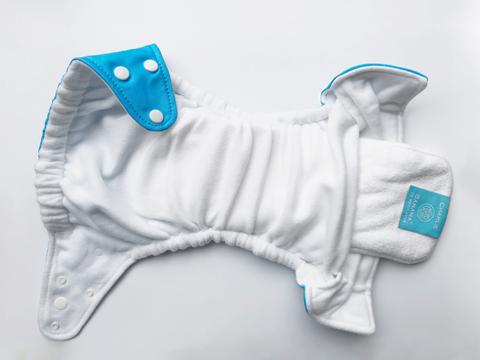
Folding not your thing? Pocket diapers are at your service. Shaped like a disposable diaper, these cloth diapers feature elastic waist and leg openings for effective mess containment and convenient fasteners (usually snaps or Velcro) for easy fit adjustment around the waist. Pocket diapers can be one-size or come in different sizes.
Just like their name suggests, these cloth diapers feature a pocket inside that needs to be stuffed with absorbent inserts. There are plenty of cloth diaper insert options to choose from, including reusable inserts made of microfiber, cotton, or hemp, and disposable inserts. Many pocket cloth diapers are lined with stay-dry material, so the baby feels dry even when they’re wet because the urine passes through the diaper lining and is absorbed inside the insert.
Pros of pocket cloth diapers:
- Easy to fasten on baby. No folding required. Good option for babysitters and daycares
- Versatile and highly customizable: it’s easy to increase absorbency by adding extra inserts or playing with different insert types. Good for overnight
- The absorbent insert is seperate, which makes washing and drying easier than with all-in-one cloth diapers
- The insert can also go on top of the diaper lining (instead of inside the pocket), which might help reuse the pocket cover before washing
- Some pocket diapers can be used with disposable inserts for traveling and on-the-go
Cons of pocket cloth diapers:
- Pricier than flats and pre-folds, but economical in the long-run compared to disposables
- Inserts might take longer to dry than flats and pre-folds
- May require sizing-up to larger pocket diapers as baby grows (unless the diaper size is adjustable, like in Charlie Banana One Size diapers)
- Requires pre-stuffing (unless you choose to use the inserts on top of the diaper lining, like with an AI2)
When should you choose pocket cloth diapers?
If you are a new cloth diaper parent or simply prioritize convenience, pocket cloth diapers could be a great choice for you. They are very easy to use, and the process of putting a pocket diaper on a baby is quite similar to a disposable diaper. Pocket diapers are also easy to wash and take care of. They are also easy to customize: if you ever need to increase the absorbency, you can add extra inserts or experiment with different insert types. Some pocket cloth diapers, like Charlie Banana, even have an option to add disposable inserts, for extra on-the-go convenience.
The upgrade in ease-of-use comes with an upgrade in cost, and even though you will be saving money in the long run (especially if you are using a one-size diaper), you might need to invest more in your stash upfront. Still, if you are looking to maximize convenience and ease-of-use, pocket diapers will likely be one of your top choices.
What are all-in-one cloth diapers (AIO)?
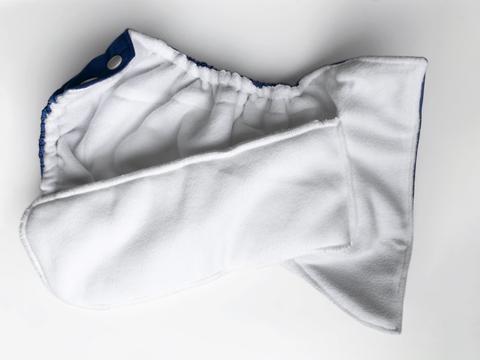
Want to keep it simple? Try the all-in-one. All-in-one (or AIO) cloth diapers are one-piece diapers that do all the work on their own without extra accessories or separate inserts. The absorbent layers are sewn into the waterproof cover, removing any extra steps from putting the diaper onto the baby. Just like pockets, the AIOs can be sized or one-size.
Pros of AIO cloth diapers:
- Easy to fit on baby with built-in fasteners
- One piece: no need for separate inserts or covers
- Good choice for daycares or babysitters, since it’s one piece
Cons of AIO cloth diapers:
- On the pricier side, compared to other types of reusable diapers
- Considerably longer drying time, since the multiple layers of fabric are sewn together
- Less customizable with absorption: may not be a good overnight option
- Tend to be bulky
When should you choose all-in-one cloth diapers?
If you are just starting out your cloth journey, an AIO diaper could be a good entry point. All-in-one cloth diapers come closest to disposables in terms of ease of use. Because they require no extra pieces or steps, which makes them great for babysitters and daycare providers.
Just like with any other type of diaper, there are some drawbacks. AIO diapers usually take longer to fully dry after the wash because of the built-in soaker. They are not easily customizable in terms of absorbency, and they are also the most expensive compared to other types of reusable diapers.
What are all-in-two cloth diapers (AI2)?
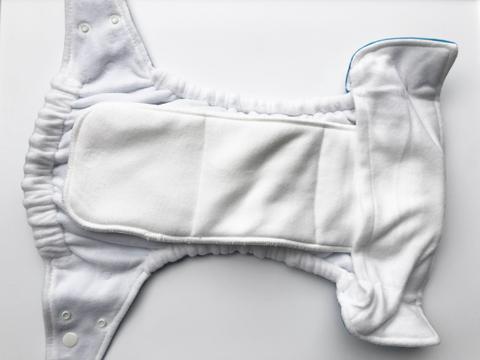
All-in-two (or AI2) diapers come in two pieces: inserts and covers. They are similar to pocket diapers, except that the insert usually snaps inside the diaper versus going inside a pocket. This is handy because you can remove and replace the wet insert without having to change the entire diaper.
Similarly to pockets and AIOs, AI2 cloth diapers can come in various sizes or just one. Because the insert in AI2s touches the baby’s skin directly, it is important to choose inserts that are lined with materials that are gentle on baby’s skin.
Did you know... Although Charlie Banana is a pocket diaper, it allows laying an insert on top of the diaper lining, just like an AI2, instead of stuffing it inside the pocket. This way, you can quickly remove wet inserts and “recycle” the waterproof shell.
Pros of AI2 cloth diapers:
- Like pockets and AIOs, AI2s are easy to fit on your baby
- Covers can be reused, since wet inserts can be removed and replaced
- Some AI2s can be used with disposable inserts
Cons of AI2 cloth diapers:
- Are more expensive to start with, mostly due to the cost of the inserts
- Removing soiled inserts could be messy
- Could be difficult to customize absorbency if you can only use one type of insert
- Require an extra step during changes to attach an insert, unless you pre-attach the inserts beforehand
- May be difficult to customize absorbency, as you can only use the inserts that have the right snap attachment
When should you choose all-in-two cloth diapers?
If you are looking for something quick and easy, all-in-two cloth diapers may be the answer you've been searching for. These diapers offer a good combination of convenience and functionality. Removable inserts are one of the main benefits of the all-in-twos, since this option allows to reuse the waterproof cover and reduces drying time. All-in-twos typically work out to be a lower-cost options than all-in-ones, but are more expensive than pre-folds
What are fitted cloth diapers?
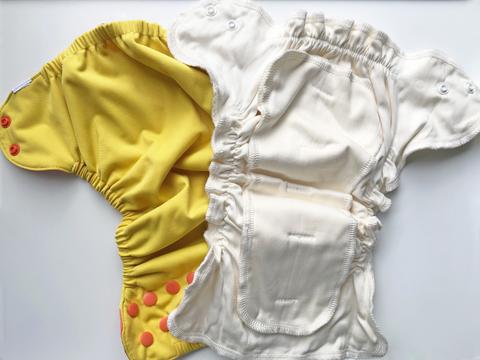
Similarly to flats and pre-folds, fitted cloth diapers require an outer waterproof diaper cover to contain the leaks. However, with a fitted diaper, the absorbent inner is an actual diaper with snaps or Velcros and elastics, rather than a flat or prefolded sheet. Fitteds are pretty easy to put on a baby, even though they require an extra step of putting on a diaper cover. Fitted diapers give your baby full-coverage absorbency, which works well for nighttime. The also give you an option to reuse the outer waterproof cover, once the inner fabric diaper becomes soiled.
Pros of fitted cloth diapers:
- Covers can be reused since inner diaper layer can be removed
- No pins required. Inner diaper stays in place, secured by its own snaps or Velcros, whereas flats or prefolds can shift inside the cover
- Full-coverage absorbency works well for nighttime
- Easier to put on a baby compared to flats and prefolds
Cons of fitted cloth diapers:
- On the pricier side, compared to basic flats and pre-folds, especially if you need to purchase multiple sizes
- Two pieces make diapering a two-step process
- Multiple layers of fabric can take longer time to dry, compared to flats
- Can be bulky, once you put the diaper cover on
When should you choose fitted cloth diapers?
Fitted cloth diapers are more convenient than flat or pre-fold diapers. The fitted diaper is easier to secure around your baby, and there no folding is required. . Fitted diapers are also very absorbent, rarely needing any boosting. If you are looking for a safe option for nighttime or a long car ride – fitted cloth diapers may be the right answer for you
Fitted diapers take longer to dry than flats or pre-fold diapers because of their design. Also, while pretty convenient, they might be the most budget-friendly option, as you might need to purchase different sizes as your baby grows.
What are hybrid cloth diapers?
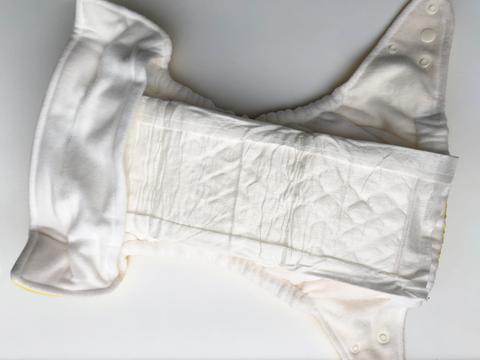
Hybrid cloth diapers were designed to make cloth diapering as easy and convenient as possible, while decreasing the waste. They’re basically a cross between cloth and disposable diapers. Hybrids consists of an outer reusable cover and a disposable insert inside. The disposable insert is placed inside the diaper against the baby’s skin, so once it becomes wet or soiled, all you have to do is toss it in the trash and replace with a new insert.
Pros of hybrid cloth diapers:
- Covers can be reused if only the disposable insert is wet
- Fewer poopy messes to launder: disposable inserts can be tossed in the trash
- Super easy for daycares and babysitters
- Great for traveling or on-the-go, when you don’t want to run around with soiled diapers
Cons of hybrid cloth diapers:
- More expensive, due to the need to repurchase disposable inserts
- While hybrids generate less waste compared to disposable diapers, you will still be generating disposable waste
When should you choose hybrid cloth diapers?
Are you curious about cloth diapers, but not sure how to get started? If you can’t decide between cloth or disposable diapers – hybrid is the answer. Going hybrid could be a great way to try cloth diapering without committing to too much laundry right away. Hybrid cloth diapers are adaptable to many situations and work great for traveling, camping, and babysitters. By using the hybrid system, you will have fewer dirty diapers to wash, while still introducing some reusable elements into your diapering journey.
Using hybrids cloth diapers is a little less wasteful than using regular disposables, but keep in mind that disposable inserts, just like disposable diapers, will end up in the landfill.
Luckily, some hybrid cloth diapers (like Charlie Banana Reusable One Size Cloth Diaper) work with both disposable and reusable inserts. This means that you can start out with disposable inserts and transition to reusable inserts as you get a hang of cloth diapering.
Types of cloth diapers comparison chart
| Flat cloth diaper | Pre-fold cloth diaper | Pocket cloth diaper | All-in-one cloth diaper (AIO) | All-in-two cloth diaper (AI2) | Fitted cloth diaper | Hybrid cloth diaper | |
|---|---|---|---|---|---|---|---|
| Cost | $ | $ | $$ | $$ | $$ | $$ | $$$ |
| Absorbent part | Flat sheet (can be folded) | Tri-folded sheet | Inserts | Sewn-in | Inserts | Whole diaper | Inserts |
| Requires separate diaper cover | Yes | Yes | No | No | No | Yes | No |
| Ease of changing | Could be easier | Could be easier | Easy | Easy | Easy | Easy | Easy |
| Ease of laundering | Could be easier | Could be easier | Easy | Easy | Easy | Could be easier | Super easy |
| Pros | Very affordable, customizable, quick drying time | Very affordable, customizable, pre-layered (less folding) | Very easy fit, customizable absorbency | Easy fit, one-piece. | Easy fit, reusable outer layer | Easy fit, full-coverage absorbency, reusable outer layer | Easy to use, super-easy cleanup, little laundering required |
| Cons | Requires folding, requires separate fasteners and covers | Requires separate fasteners and covers | More expensive than flats and prefolds, requires stuffing | Price, longer drying time, less customizable absorbency | Multiple steps, requires more than one piece, less customizable absorbency | Longer drying time, most require purchasing multiple sizes | Expensive, generates landfill waste |
How do you choose which cloth diaper is right for you?
Different people like different styles and brands, and what works for one baby may not be a great choice for another. When deciding on which cloth diaper style is right for your family, you should consider the different types of diapers, sized vs one-size options, whether the diaper will require an extra cover, types of fabric you prefer, ease of use, and price. With so many options, navigating the choices can get a little confusing, and sometimes it just takes a little experimenting to see what works best for your family. Before committing to one type of cloth diaper, try a few. You may discover there are several aspects you like about each.
What makes Charlie Banana cloth diapers different?
Softness, ease of use, quality of materials and construction, plus cute designs – this is what we hear most often when we ask our customers what they love about Charlie Banana cloth diapers . Many also praise the unique leg elastic adjuster that helps prevent leaks and our highly absorbent inserts.
Charlie Banana one size pocket diapers and inserts are lined with luxurious fleece, so that only soft materials touch your baby’s skin. Thanks to a unique leg-sizing adjuster and only two rows of snaps, these cloth diapers grow with baby from newborn to potty-trained. All Charlie Banana products are tested for 350 harmful substances and certified under the strictest Annex 6 of Standard 100 by OEKO-TEX®. Because we only use high-quality materials, our diapers can withstand multiple washes, so that you can reuse them on multiple children.
Charlie Banana pocket diapers can be used with reusable or disposable inserts, or a combination of both. Our absorbent inserts contain 4 layers of terry and can soak up an overnight load of liquid. For maximum absorbency, you can use 2 inserts.
Want to learn more about Charlie Banana? Discover how our cloth diapers work and what diapering accessories you need to make cloth diapering easier than ever before.